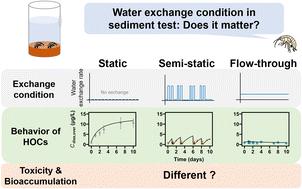当前位置:
X-MOL 学术
›
Environ. Sci.: Processes Impacts
›
论文详情
Our official English website, www.x-mol.net, welcomes your feedback! (Note: you will need to create a separate account there.)
Influence of water exchange rates on toxicity and bioaccumulation of hydrophobic organic chemicals in sediment toxicity tests
Environmental Science: Processes & Impacts ( IF 5.5 ) Pub Date : 2023-01-25 , DOI: 10.1039/d2em00462c Kyoshiro Hiki 1 , Fabian Christoph Fischer 1 , Takahiro Nishimori 1 , Satoshi Endo 1 , Haruna Watanabe 1 , Hiroshi Yamamoto 1
Environmental Science: Processes & Impacts ( IF 5.5 ) Pub Date : 2023-01-25 , DOI: 10.1039/d2em00462c Kyoshiro Hiki 1 , Fabian Christoph Fischer 1 , Takahiro Nishimori 1 , Satoshi Endo 1 , Haruna Watanabe 1 , Hiroshi Yamamoto 1
Affiliation

|
In standardized sediment toxicity tests, the applied water exchange methods range from static to flow-through conditions and vary between protocols and laboratories even for the same test species. This variation potentially results in variable chemical exposure, hampering the interpretation of toxicity and bioaccumulation. To address these issues, we performed sediment toxicity tests with a mixture of three polycyclic aromatic hydrocarbons (PAHs) and the freshwater epibenthic amphipod Hyalella azteca as model chemicals and organism, respectively. Five standardized water exchange methods were applied: static, semi-static, or flow-through conditions. By measuring total (Cdiss) and freely dissolved concentrations (Cfree) of PAHs with water sampling and direct immersion solid-phase microextraction methods, respectively, we found that Cdiss in overlying water differed by a factor of up to 107 among water exchange conditions, whereas both Cdiss and Cfree in pore water did not differ by more than a factor of 2.6. Similar survival rates, growth rates, and bioaccumulation of PAHs between water exchange methods suggest that H. azteca was predominantly exposed to pore water rather than overlying water. By applying mechanistic kinetic modeling to simulate spatiotemporal concentration profiles in sediment toxicity tests, we discuss the importance of the water exchange rates and resulting temporal and spatial exposure variability for the extrapolation of laboratory sediment toxicity to field conditions, particularly for chemicals with relatively low hydrophobicity and sediments with low organic carbon content.
中文翻译:

水交换率对沉积物毒性试验中疏水性有机化学品毒性和生物积累的影响
在标准化的沉积物毒性测试中,应用的水交换方法从静态到流通条件不等,并且在协议和实验室之间有所不同,即使对于相同的测试物种也是如此。这种变化可能导致不同的化学暴露,妨碍对毒性和生物蓄积的解释。为了解决这些问题,我们分别使用三种多环芳烃 (PAH) 和淡水底栖片脚类Hyalella azteca的混合物作为模型化学品和生物体,进行了沉积物毒性测试。应用了五种标准化的水交换方法:静态、半静态或流通条件。通过测量总浓度 ( C diss ) 和自由溶解浓度 ( C free) 分别采用水样和直接浸没固相微萃取方法对多环芳烃进行分析,我们发现上覆水中的C diss在水交换条件下相差高达 107 倍,而孔隙水中的C diss和C free则没有相差超过 2.6 倍。水交换方法之间多环芳烃的相似存活率、生长率和生物蓄积表明H. azteca主要暴露于孔隙水而不是上覆水。通过应用机械动力学模型来模拟沉积物毒性测试中的时空浓度分布,我们讨论了水交换率的重要性以及由此产生的时间和空间暴露变异性对于将实验室沉积物毒性外推到现场条件的重要性,特别是对于疏水性和相对较低的化学品有机碳含量低的沉积物。
更新日期:2023-01-25
中文翻译:

水交换率对沉积物毒性试验中疏水性有机化学品毒性和生物积累的影响
在标准化的沉积物毒性测试中,应用的水交换方法从静态到流通条件不等,并且在协议和实验室之间有所不同,即使对于相同的测试物种也是如此。这种变化可能导致不同的化学暴露,妨碍对毒性和生物蓄积的解释。为了解决这些问题,我们分别使用三种多环芳烃 (PAH) 和淡水底栖片脚类Hyalella azteca的混合物作为模型化学品和生物体,进行了沉积物毒性测试。应用了五种标准化的水交换方法:静态、半静态或流通条件。通过测量总浓度 ( C diss ) 和自由溶解浓度 ( C free) 分别采用水样和直接浸没固相微萃取方法对多环芳烃进行分析,我们发现上覆水中的C diss在水交换条件下相差高达 107 倍,而孔隙水中的C diss和C free则没有相差超过 2.6 倍。水交换方法之间多环芳烃的相似存活率、生长率和生物蓄积表明H. azteca主要暴露于孔隙水而不是上覆水。通过应用机械动力学模型来模拟沉积物毒性测试中的时空浓度分布,我们讨论了水交换率的重要性以及由此产生的时间和空间暴露变异性对于将实验室沉积物毒性外推到现场条件的重要性,特别是对于疏水性和相对较低的化学品有机碳含量低的沉积物。


























 京公网安备 11010802027423号
京公网安备 11010802027423号